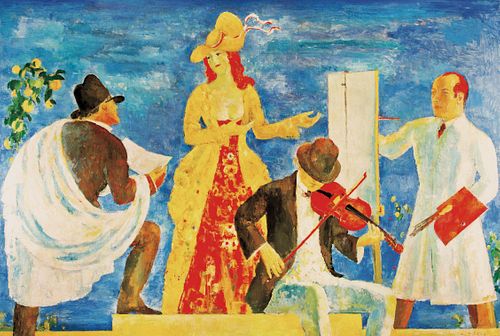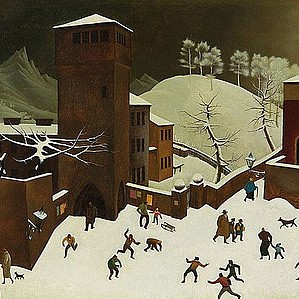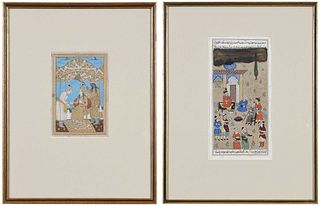WILHELM THÖNY (Graz 1888 - 1949 New York) The Fine Arts, 1923
Lot 88
Estimate:
EUR€300,000 - EUR€600,000
$312,500 - $625,000
Absentee vs Live bid
Two ways to bid:
- Leave a max absentee bid and the platform will bid on your behalf up to your maximum bid during the live auction.
- Bid live during the auction and your bids will be submitted real-time to the auctioneer.
Bid Increments
| Price | Bid Increment |
|---|---|
| EUR€0 | EUR€10 |
| EUR€100 | EUR€50 |
| EUR€700 | EUR€100 |
| EUR€1,000 | EUR€200 |
| EUR€3,000 | EUR€300 |
| EUR€3,600 | EUR€400 |
| EUR€4,000 | EUR€500 |
| EUR€7,000 | EUR€1,000 |
| EUR€16,000 | EUR€2,000 |
| EUR€30,000 | EUR€3,000 |
| EUR€36,000 | EUR€4,000 |
| EUR€40,000 | EUR€5,000 |
About Auction
By Widder Auctions
May 19, 2022
Set Reminder
2022-05-19 11:00:00
2022-05-19 11:00:00
America/New_York
Bidsquare
Bidsquare : Masterpieces
https://www.bidsquare.com/auctions/widder-auctions/masterpieces-9287
Masterpieces of classical modernism by Austrian and international artists coming up for auction in Vienna on May 19th Widder Auctions office@widderauktionen.com
Masterpieces of classical modernism by Austrian and international artists coming up for auction in Vienna on May 19th Widder Auctions office@widderauktionen.com
- Lot Description
WILHELM THÖNY
(Graz 1888 - 1949 New York)
The Fine Arts, 1923
oil/canvas, 180 x 265 cm
signed W. Thöny
depicted in cat. raisonné Wilhelm Thöny, Im Sog der Moderne, Graz 2013, N. 156
Provenance: Theatercafe Thalia Graz, private collection Italy, private collection Austria
ESTIMATE °€ 300.000 - 600.000
Austrian painter, graphic artist, etcher and illustrator of the 20th century, important representative of Austrian modernism. 1908 to 1912 studied at the Academy of Fine Arts with Angelo Jank and Gabriel von Hackl. Also training in singing and playing the piano. Co-founder of the Munich Secession, lifelong acquaintance with Alfred Kubin. As a one-year volunteer in World War I, he created portrait studies and illustrations as a regimental painter. 1923 co-founder of the Graz Secession. 1925 Marries Thea Herrmann-Trautner, daughter of the American painter Frank S. Herrmann, sister of the painter and caricaturist Eva Herrmann. 1929 first stay in Paris, lived in Paris from 1931 to 1938. 1938 Emigrated to New York with his Jewish wife. 1948 Destruction of most of his works in a fire in a warehouse in New York. Diverse themes and techniques, landscapes and above all cityscapes of large cities such as Paris and New York. The genre scenes also show engagement with Advard Munch and August Macke.
Wilhelm Thöny occupies a prominent position in Austrian modernism of the interwar period. Coming from the Styrian capital of Graz, which was artistically overshadowed by Vienna at the time, Thöny did not go to Vienna in 1908 to study art – like many of his artist colleagues – but to the more progressive Munich. At this point in time, his inclinations were initially divided equally between music and painting, and he was still undecided as to which of the two arts he wanted to devote himself to. It was only when Thöny received an offer as a singer that he decided against music and concentrated on his career as an aspiring visual artist. After a stay in Switzerland, Wilhelm Thöny returned to Graz in 1923, where he founded the Graz Secession together with Alfred Wickenburg, Fritz Silberbauer and Axel Leskoschek, of which he became the first president. The paintings and watercolors of the post-war period are shaped by the experiences of the war and influenced by a gloom that is expressed in melancholy colors determined by dark paints. At the same time, Thöny was also a man of society. He regularly attended the theatre, the opera and concerts and watched the actors and musicians with passion. Against this background, it is not surprising that he produced three pictures for the Thalia theater café in Graz at exactly the same time, in the year of his arrival in Graz. The two sibling pictures are in collections of museums and represent drama and opera. Poetry, music and painting are symbolized in this piece. In front of a plain blue background, framed by fruit-bearing plants, the figures of poetry and drama as well as music and painting sit and stand side by side. The figures are positioned on a pedestal, with Thöny giving the most important place to the art of acting. In the embodiment of an elegantly dressed lady with fiery red hair, she stands on the highest level. She is inclined towards the poet or an actor who has put one foot on the podium and is reciting from the page, bent over. The sitter is probably Herbert Thöny, Wilhelm's brother, who was a successful baritone at the Graz Opera. The violinist on the showwoman's right is engrossed in his playing, his face hidden by the brim of his deep-drawn hat. He provides the musical accompaniment to the scene and remains anonymous. Finally, the art of painting is embodied on the right edge of the picture. It is a self-portrait by Thöny that shows him standing upright with a concentrated gaze. In a self-confident pose he stands in front of the easel and captures the depiction. In terms of colour, Thöny limits the painting to five colors and emphasizes important details with a well-considered color scheme. All too often the term major work is used to praise a painting. This is justified in the large-format painting in which Wilhelm Thöny takes us into the world of fine art and allegory.
PLEASE NOTE:
The purchase price consists of the highest bid plus the buyer's premium, sales tax and, if applicable, the fee of artists resale rights. In the case of normal taxation (marked ° in the catalog), a premium of 24% is added to the highest bid. The mandatory sales tax of 13% is added to the sum of the highest bid and the buyer's premium. The buyer's premium amounts to 28% in case of differential taxation. The sales tax is included in the differential taxation. - Shipping Info
-
Shipping
We will send you the invoice shortly after the auction. As soon as we have recieved the amount, the art can be picked up at Johannesgasse 9-13, 1010 Vienna. Please note that the buyer is responsible for pick-up and shipping of the lot.
Should you wish to ship your items, please contact: Mailboxes Email: oper@mbe-co.at Tel: 01 5128855
Please note that storage fees may apply, should the pieces not be picked up within 14 days after invoicing for domestic and 28 days for international transportation.
Our team will be happy to assist you with any further information at office@widderauktionen.com or at 0043 676 555 66 10.
-
- Buyer's Premium



 EUR
EUR CAD
CAD AUD
AUD GBP
GBP MXN
MXN HKD
HKD CNY
CNY MYR
MYR SEK
SEK SGD
SGD CHF
CHF THB
THB













